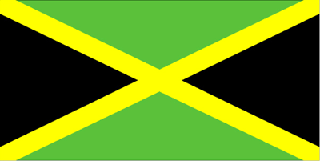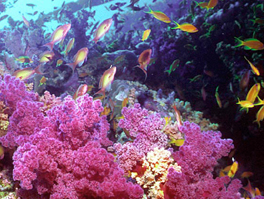|
|
|
|
|
The list of
organisms directly involved in this case have been narrowed to five groups.
Provided for you are some general information about the organisms' eating
habits, size, and other notes. Create a diagram
showing the relationships between the organisms.
|
|
|
|
|
|
|
|
- predatory fish
- herbivorous fish
|
|
|
|
|
| CORAL |
|
|
Reef-building
coral
- >60
species of reef-building corals occur around Jamaica; the
following four species are most dominant
- DIET:
plankton and detritus (small broken pieces of dead plants
and animals)
- PREDATORS:
parrotfish, butterflyfish, echinoderms, gastropods
- DISTRIBUTION:
- NOTE:
colonial animal related to sea anemones and jellies; not
all coral species build reefs
|
 |
|

|
The
four most important structural corals in Jamaica are:
- Acropora
palmata, branching elkhorn coral
- Acropora
cervicornis, branching staghorn coral
- Montastrea
annularis, massive or platelike, and are most important
framework coral
- Agaricia
agaricites, encrusting
or foliose
(www.coralreef.org/resources/photobank.html) |
|
|
|
|
| REEF
FISH |
|
|
|
|
Predatory
fish
- include:
sharks, lutjanids (snappers), carangids (jacks), ballistids
(triggerfish), and serranids (groupers)
- DIET:
other reef fish
- PREDATORS:
other reef fish, humans
- NOTE:
Their large size make some of these fish target species
for fishers
|
Herbivorous
fish
- include:
scarids (parrotfish) and acanthurids (surgeonfish)
- DIET:
macroalgae
- PREDATORS:
other reef fish, humans
- NOTE:
These fish compete with sea urchins for macroalgae on the
reef
(www.coralreef.org/resources/photobank.html)
|
|
|
|
|
| ECHINODERMS |
|
|
Sea
urchin, Diadema antillarum
- DIET:
macroalgae
- PREDATORS:
reef fish, .e.g ballistids (triggerfish), sparids (porgies),
and batrachoidids (toadfish)
- NOTE:
a major herbivore on Caribbean reefs
|
 |
|
|
|
|
| ALGAE |
|
- DIET:
use sunlight, nitrogen, and phosphorous to produce its own
food.
- PREDATORS:
herbivores
- NOTE:
benthic algae grow faster than reef-building coral, and
thus can overgrow and smother corals if grazing is reduced.
(www.globaldialog.com/~jrice/algae_page/halimeda.htm)
|
 |
|
|
|
|
| HUMANS |
|

|
- POPULATION:
2,652,689 (July 2000 est.)
- ETHNIC
GROUPS: black 90.9%, East Indian 1.3%, white 0.2%, Chinese
0.2%, mixed 7.3%, other 0.1%
- RELIGIONS:
Protestant 61.3% (Church of God 21.2%, Baptist 8.8%, Anglican
5.5%, Seventh-Day Adventist 9%, Pentecostal 7.6%, Methodist
2.7%, United Church 2.7%, Brethren 1.1%, Jehovah's Witness
1.6%, Moravian 1.1%), Roman Catholic 4%, other, including
some spiritual cults 34.7%
- LANGUAGES:
English, Creole
- INDUSTRIES:
tourism, bauxite, textiles, food processing, light manufactures,
rum, cement, metal, paper, chemical products
|
|
|
|
|
| |
This web
site was created by Lynn Tran at the North Carolina State University, Department
of Mathematics, Science, and Technology Education on 7/12/03. Faculty advisor
Dr. David Eggleston, NCSU, Department of Marine, Earth, & Atmospheric Sciences.
Last updated
December 29, 2003
.
|






